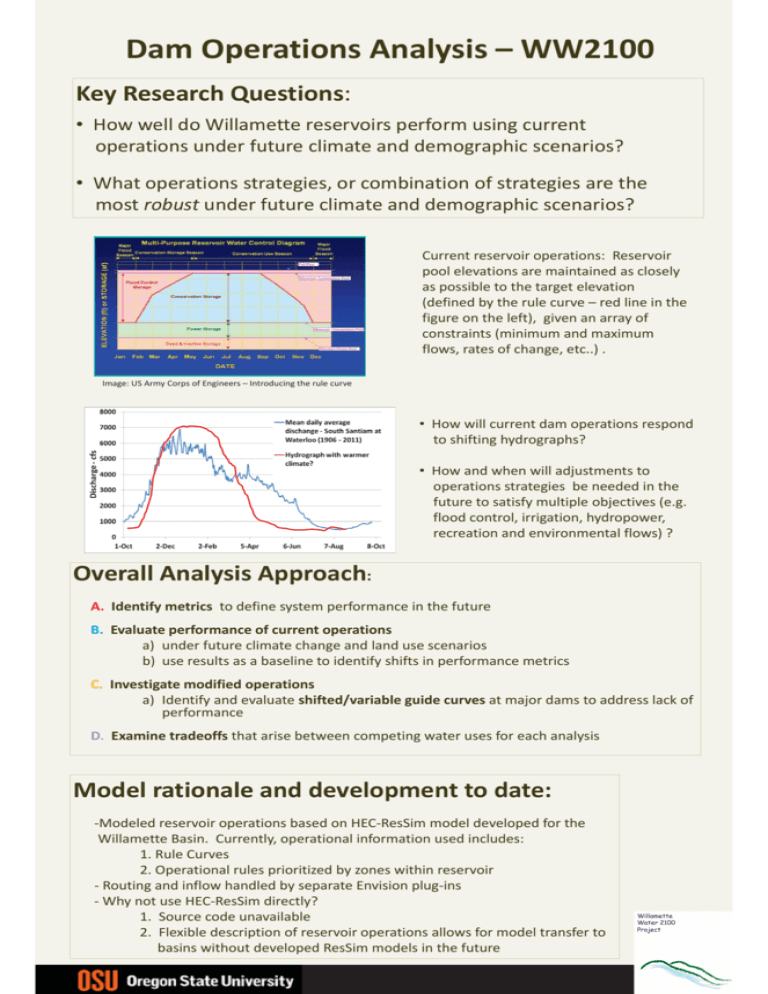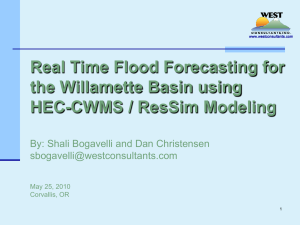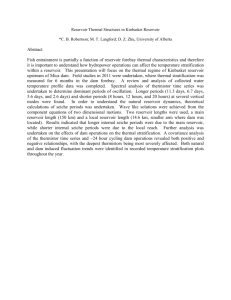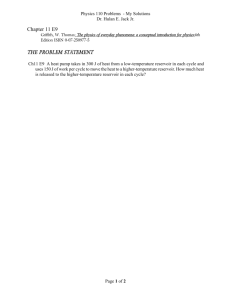Dam Operations Analysis – WW2100
advertisement

Dam Operations Analysis – WW2100 Key Research Questions: • How well do Willamette reservoirs perform using current operations under future climate and demographic scenarios? • What operations strategies, or combination of strategies are the most robust under future climate and demographic scenarios? Current reservoir operations: Reservoir pool elevations are maintained as closely as possible to the target elevation (defined by the rule curve – red line in the figure on the left), given an array of constraints (minimum and maximum flows, rates of change, etc..) . Image: US Army Corps of Engineers – Introducing the rule curve • How will current dam operations respond to shifting hydrographs? • How and when will adjustments to operations strategies be needed in the future to satisfy multiple objectives (e.g. flood control, irrigation, hydropower, recreation and environmental flows) ? Overall Analysis Approach: A. Identify metrics to define system performance in the future B. Evaluate performance of current operations a) under future climate change and land use scenarios b) use results as a baseline to identify shifts in performance metrics C. Investigate modified operations a) Identify and evaluate shifted/variable guide curves at major dams to address lack of performance D. Examine tradeoffs that arise between competing water uses for each analysis Model rationale and development to date: -Modeled reservoir operations based on HEC-ResSim model developed for the Willamette Basin. Currently, operational information used includes: 1. Rule Curves 2. Operational rules prioritized by zones within reservoir - Routing and inflow handled by separate Envision plug-ins - Why not use HEC-ResSim directly? 1. Source code unavailable 2. Flexible description of reservoir operations allows for model transfer to basins without developed ResSim models in the future Willamette Water 2100 Project A. Reservoir Performance Metrics: Metric development –Based on current targets (flow targets from the 2008 Biological Opinion, current control point channel capacities, etc..) –Attempt to encompass most relevant management objectives (both today and in future) Metrics paired to address: a) The duration of failures: reliability b) The magnitude of failures: vulnerability Metrics by relevant management objectives: Flood Control, Environmental Flows, Recreation, Hydropower, Water Supply Feedback/Questions about Reservoir Performance Metrics: (Please see handouts for details on the formulation of individual performance metrics): Questions for stakeholders: •What future management objectives do you anticipate that we're not facing today? •How do you feel that the management objectives above should be prioritized today? In the future? •How do you see management objectives changing in the future? •What role do you think the Willamette dams have to play in adaptation to a changing climate? B. Evaluation of Current Reservoir Performance: Analysis Steps: 1.Run the model repeatedly for the future time period with projected climate and demand changes to streamflow values 2.Calculate performance metrics at each reservoir or control point 3. Examine future performance measures probabilistically Potential model output format, (adapted from Georgakakos et. al. 2011). Feedback/Questions about evaluation of current reservoir performance: Willamette Water 2100 Project C. Investigate Modified Reservoir Operations 1. Perform a sensitivity analysis using each future landscape trajectory Identify high priority reservoirs (highly sensitive in one scenario or sensitive in all scenarios) for operational changes and develop variable or alternative/ variable rule curves for only these? 2. Minimize performance failures using each future landscape trajectory Allow releases to vary within a particular range Minimize performance failures at each time step Modeled releases become new rule curves in future operations scenarios Variable Rule Curves: Target pool elevations are variable based on long range forecasts updated once or twice monthly. Feedback/Questions about Modified Reservoir Operations to consider: D. Examine Tradeoffs The impacts of various reservoir operations scenarios on multiple performance metrics will be examined side by side, as shown above. Tradeoffs between two competing water use metrics can be examined (weighting by the resource manager determines position on the pareto curve shown above). Feedback/Questions about analysis of tradeoffs: Question for stakeholders: What outputs about dam operations performance would be most useful to you for future long term planning? References: Brekke, L.D., E.P. Maurer, J.D. Anderson, M.D. Dettinger, E.S. Townsley, A. Harrison and T.Pruitt (2009), Assessing reservoir operations risk under climate change, Water Resour. Res, 45, W04411, doi:10.1029/2008Wr006941. Georgakakos, A.P., et al. Value of adaptive water resources management in Northern California under climatic variability and change: Reservoir management. J. Hydrol. (2011), doi:10.1016/j.jhydrol.2011.04.038 Willamette Water 2100 Project







